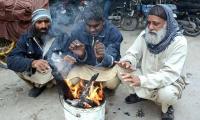Side-effect
The writer is a poet and author based in Islamabad.
This is in continuation of the last point I made in the previous column. Boys will be boys unless they are not just socially sensitised to believe in the equality of women but are actually made to treat women equally through effective structural reform and clear policy shifts by the state.
In order to make this world liveable, it is essential that women and girls do not simply partake in but lead the process of making those decisions that affect their lives and the lives of the communities they live in.
In this atmosphere of doom and gloom, when schools in most parts of the country were shut for fear of terrorist attacks, when if not the only but a dominant public discourse blatantly propounds further marginalisation of women, minorities, weak and the dispossessed, and the dialogue between competing ideas has turned into a violent clash between reason and unreason, a silver lining appeared on the grey skies of Islamabad last week.
A large number of women community leaders and some leading women’s rights campaigners from all across the region gathered in the Pakistani capital for a conference to deliberate on women’s leadership in South Asia, the constraints, the oppression, the glass ceilings even when some are allowed to rise through the ranks, and the availability of spaces and opportunities for them to grow.
Undoubtedly, South Asia is the only region where women have been elected to the highest political offices in significant numbers. This may have happened by accident or by association but the fact remains that Sirimavo Bandaranaike and Chandrika Kumaratunga in Sri Lanka, Indira Gandhi in India, Benazir Bhutto in Pakistan, and Shaikh Hasina and Khalida Rehman in Bangladesh have all served as prime ministers or presidents. Currently, the president of Nepal, Bidhya Devi Bhandari, is a woman who has risen through the cadres of leftist politics in the country which transformed Nepal from a monarchy into a republic. She is perhaps the only woman head of the state or government in the region who has not come from the elite.
Women have also served as chief ministers of provinces and states and speakers of national legislatures and continue to serve in many such positions within these countries. But most of these women, as mentioned before, came from the upper echelons of society and became leaders either due to the support of a patriarch they were related to or the assassination of their fathers or husbands.
The purpose is not to undermine their contribution for marginalised groups in some cases – Benazir’s institutionalisation of Lady Health Workers across Pakistan or the amendments made to the Criminal Procedure Code to protect women being a couple of examples. But one must emphasise the fact that while we witness the elevation of women to the highest political offices, there is little representation of women in legislative bodies outside quotas assigned for them and even less involvement at lower levels of decision-making that impact their day-to-day life and existence.
Also, little was done to dent the patriarchal norms in these countries as, unfortunately, elite or affluent middle-class women have class interests to protect which are interwoven with economic structures that are purely patriarchal in nature.
Gender cannot and should not be separated from class. While it is important to recognise that women rights cannot be realised in isolation from the rights of peasants, workers and ordinary citizens. It is equally critical to appreciate the need for a grassroots women’s movement if any gains have to be consolidated. I know a little more about Pakistan than other countries in the region. Our experience here tells us that the women’s movement in its present form began during General Zia’s martial rule; the movement was in response to the anti-women legislation and subsequent subjugation of women in the country. It was largely, if not entirely, a middle-class educated women’s movement.
No denying the importance or the contribution of these women who took upon themselves the representation of women of all classes and backgrounds. However, it is imperative now that the urban middle-class movement transforms completely into a grassroots movement with a multi-class character. For that to happen, women at the community level – working women in factories and offices, peasant women, home-based workers, teachers and nurses, artisans and unskilled labour, home makers and cattle keepers – have to be supported, strengthened, capacitated and encouraged to assume leadership positions, take charge of their lives, assert their rights, associate with each other and engage with governments and private sector for realisation of their rights and to influence decisions that are made to regulate society, economy, culture and politics.
The uniqueness of the recently held conference of women community leaders in Islamabad was its regional character and the demonstration of belief in solidarity and collective action for peace in the region besides the women empowerment agenda. Since the next summit of South Asian Association for Regional Cooperation (Saarc) is scheduled to be held in Islamabad in November this year, the women community leaders’ conference aimed at bringing the promotion of women’s leadership as an agenda point at the summit. The Saarc summit is significant as this time around the summit is supposed to bring the executive heads of the governments of member countries, not just the heads of states, who will discuss ways and means of increasing regional cooperation.
The conference’s resolution particularly referred to the Sustainable Development Goals (SDGs) agreed upon by Saarc member states and highlighted the significance of Goals 5 and 16 for women in the current period of turmoil and insecurity in the region. SDG 5 is to achieve gender equality and empower all women and girls. SDG 16 is to promote peaceful and inclusive societies for sustainable development, provide access to justice for all and build effective, accountable and inclusive institutions at all levels.
Women participants called upon Saarc leaders to establish an SDG Desk with particular focus on tracking and ensuring that the goals are met within the stipulated time. They reiterated the demand for declaring a region-wide policy besides national policies and institution of mechanisms to eliminate all forms of violence against women and girls. The conference provided an opportunity for women to learn from each other and from the guest speakers. The major thrust of their demands remained on ensuring inclusion of women community leaders and women at large in all types of decision-making including intra and inter-state peace and security issues.
Women and children remain the worst victims of war, violence and terrorism. Women are almost invisible in any initiatives that are taken. The character of inter-community and inter-state relationships will substantially change if women are brought into the equation. If they are in larger numbers and come from different classes, the patriarchal moulds and role models that some of them follow at times when in position of power will get broken.
One article in the resolution of the conference reflected the dismay felt by women from across the region with the portrayal of women in media. Some said that on the one hand, print and electronic media in the region takes pride in espousing progressive causes and making governments and other power centres accountable but on the other hand, thrives on anti-women stereotypical content. In both news and entertainment, the women demanded the member states of Saarc to monitor and articulate punitive action against media if such content is used.
A Saarc Member States’ Community Women’s Alliance will be formed as an outcome of the conference. The alliance will continue to lobby with the respective governments and the regional inter-state body to make sure that when representatives from these countries meet, their deliberations are not limited to expanding markets, trade, commerce, industry, banking, etc. The empowerment of women and girls in the region and realisation of fundamental rights of 1.5 billion South Asians stays on top of the agenda.
Email: harris.khalique@gmail.com
There are over 11 million Pakistanis settled abroad, out of which around six million work in Gulf and Middle East
This year alone, US Treasury would have to roll-over $10 to $14 trillion in maturing short-term debt
Tear gas no longer marks just protest sites; it paints entire cities as battlegrounds but then again, PTI did it first
Political structures and governance systems have been central to economic and social development
It is confirmed now 40 Pakistanis had died after boat of migrants had capsized in sea near Greece
Many people believe that in future, AI will play an even more significant role in their lives







